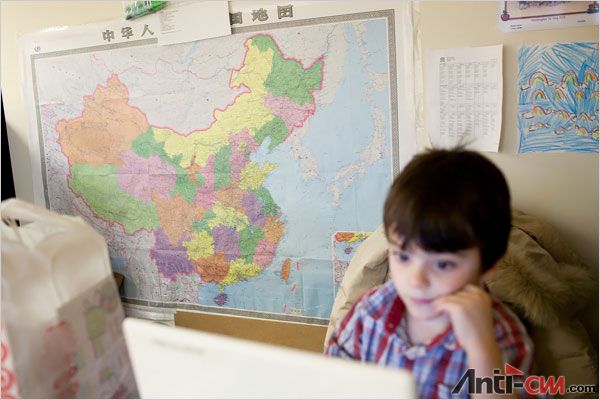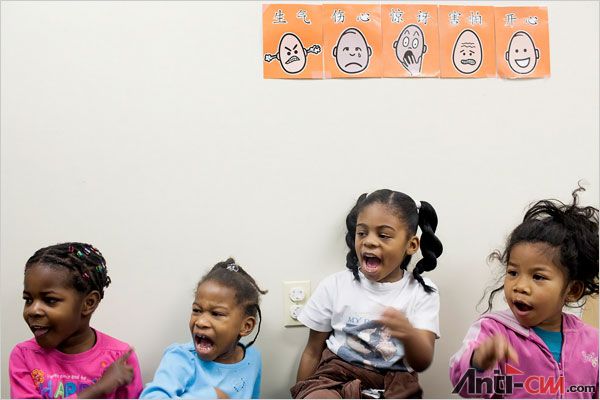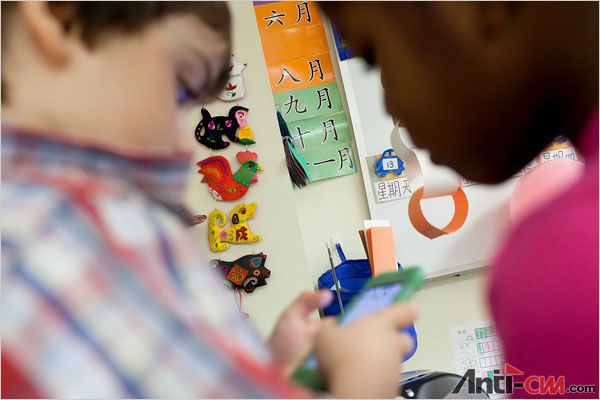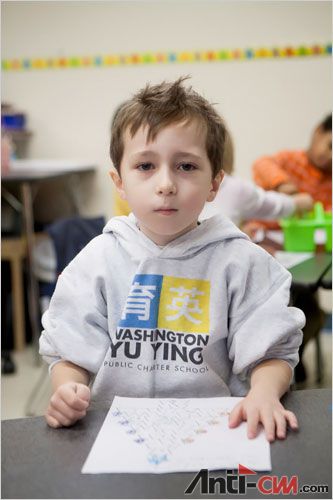本帖最后由 满仓 于 2010-1-23 14:40 编辑
【中文标题】美国学校逐渐取消外语课程 - 中文除外
【原文标题】Foreign Languages Fade in Class - Except Chinese
【登载媒体】纽约时报
【原文作者】SAM DILLON
【原文链接】http://www.nytimes.com/2010/01/21/education/21chinese.html
WASHINGTON — Thousands of public schools stopped teaching foreign languages in the last decade, according to a government-financed survey — dismal news for a nation that needs more linguists to conduct its global business and diplomacy.
But another contrary trend has educators and policy makers abuzz: a rush by schools in all parts of America to offer instruction in Chinese.
Some schools are paying for Chinese classes on their own, but hundreds are getting some help. The Chinese government is sending teachers from China to schools all over the world — and paying part of their salaries.
At a time of tight budgets, many American schools are finding that offer too good to refuse.
In Massillon, Ohio, south of Cleveland, Jackson High School started its Chinese program in the fall of 2007 with 20 students and now has 80, said Parthena Draggett, who directs Jackson’s world languages department.
“We were able to get a free Chinese teacher,” she said. “I’d like to start a Spanish program for elementary children, but we can’t get a free Spanish teacher.”
(Jackson’s Chinese teacher is not free; the Chinese government pays part of his compensation, with the district paying the rest.)
No one keeps an exact count, but rough calculations based on the government’s survey suggest that perhaps 1,600 American public and private schools are teaching Chinese, up from 300 or so a decade ago. And the numbers are growing exponentially.
Among America’s approximately 27,500 middle and high schools offering at least one foreign language, the proportion offering Chinese rose to 4 percent, from 1 percent, from 1997 to 2008, according to the survey, which was done by the Center for Applied Linguistics, a research group in Washington, and paid for by the federal Education Department.
“It’s really changing the language education landscape of this country,” said Nancy C. Rhodes, a director at the center and co-author of the survey.
Other indicators point to the same trend. The number of students taking the Advanced Placement test in Chinese, introduced in 2007, has grown so fast that it is likely to pass German this year as the third most-tested A.P. language, after Spanish and French, said Trevor Packer, a vice president at the College Board.
“We’ve all been surprised that in such a short time Chinese would grow to surpass A.P. German,” Mr. Packer said.
A decade ago, most of the schools with Chinese programs were on the East and West Coasts. But in recent years, many schools have started Chinese programs in heartland states, including Ohio and Illinois in the Midwest, Texas and Georgia in the South, and Colorado and Utah in the Rocky Mountain West.
“The mushrooming of interest we’re seeing now is not in the heritage communities, but in places that don’t have significant Chinese populations,” said Chris Livaccari, an associate director at the Asia Society.
America has had the study of a foreign language grow before, only to see the bubble burst. Many schools began teaching Japanese in the 1980s, after Japan emerged as an economic rival. But thousands have dropped the language, the survey found.
Japanese is not the only language that has declined. Thousands of schools that offered French, German or Russian have stopped teaching those languages, too, the survey found.
To prepare the survey, the Center for Applied Linguistics sent a questionnaire to 5,000 American schools, and followed up with phone calls to 3,200 schools, getting a 76 percent response rate.
The results, released last year, confirmed that Spanish was taught almost universally. The survey found that 88 percent of elementary schools and 93 percent of middle and high schools with language programs offered Spanish in 2008.
The overall decline in language instruction was mostly due to its abrupt decline in public elementary and middle schools; the number of private schools and public high schools offering at least one language remained stable from 1997 to 2008.
The survey said that a third of schools reported that the federal No Child Left Behind law, which since 2001 has required public schools to test students in math and English, had drawn resources from foreign languages.
Experts said several factors were fueling the surge in Chinese. Parents, students and educators recognize China’s emergence as an important country and believe that fluency in its language can open opportunities.
Also stoking the interest has been a joint program by the College Board and Hanban, a language council affiliated with the Chinese Education Ministry, that since 2006 has sent hundreds of American school superintendents and other educators to visit schools in China, with travel costs subsidized by Hanban. Many have started Chinese programs upon their return.
Since 2006, Hanban and the College Board have also sent more than 325 volunteer Chinese “guest teachers” to work in American schools with fledgling programs and paying $13,000 to subsidize each teacher’s salary for a year. Teachers can then renew for up to three more years.
The State Department has paid for a smaller program — the Teachers of Critical Languages Program — to bring Chinese teachers to schools here, with each staying for a year.
In the first two years of its Chinese program, the Jackson District in Ohio said it had provided its guest teacher housing, a car and gasoline, health insurance and other support worth about $26,000. This year, the district is paying a more experienced Chinese guest teacher $49,910 in salary and other support, in addition to the $13,000 in travel expenses he receives from Hanban, bringing his compensation into rough parity with Ohio teachers.
Ms. Draggett visited China recently with a Hanban-financed delegation of 400 American educators from 39 states, and she came back energized about Jackson’s Chinese program, she said.
“Chinese is really taking root,” she said. Starting this fall, Jackson High will begin phasing out its German program, she said.
Founders of the Yu Ying charter school in Washington, where all classes for 200 students in prekindergarten through second grade are taught in Chinese and English on alternate days, did not start with a guest teacher when it opened in the fall of 2008.
“That’s great for many schools, but we want our teachers to stay,” said Mary Shaffner, the school’s executive director.
Instead, Yu Ying recruited five native Chinese speakers living in the United States by advertising on the Internet. One is Wang Jue, who immigrated to the United States in 2001 and graduated from the University of Maryland.
After just four months, her prekindergarten students can already say phrases like “I want lunch” and “I’m angry” in Chinese, Ms. Wang said.
根据一项政府出资的调查,过去十年里,美国有数千所学校停止了外语教学。对一个需要大量外语人才来从事全球贸易和外交活动的国家来说,这是一个可悲的消息。
但是另外一个相反的趋势却值得教育界人士和政策制定者们振奋:美国各地的学校纷纷兴起了一股开设中文课程的热潮。

有些学校自己掏钱开设中文课程,但是更多的学校在寻求外界的帮助。中国政府向全世界派遣中文教师,并且还支付部分的工资。
在资金紧缺的情况下,很多美国学校无法拒绝这么好的方案。
俄亥俄州克利夫兰南部的马西隆,杰克逊高中国籍语言部主任Parthena Draggett说,学校在2007年秋天开设了中文课程,当时只有20名学生,现在达到了80人。
她说:“我们当时可以得到免费的中文教师。我们也想给低年级的学生开设西班牙语课程,但是找不到免费的西班牙语教师。”
(杰克逊高中的中文教师其实并不免费。中国政府支付一部分工资,其余部分由当地政府支付。)

没有人准确计算过具体的数量,但是根据政府的调查粗略估算,大约有1600家美国公立和私立学校在教授中文。在十年前,这个数字是300。可以看到,数字是在以指数趋势增长。
这项调查是由华盛顿的一家研究机构——应用语言中心主导的,由联邦教育部出资。调查显示,在全美27500所至少开设一门外语课程的中学里,从1997年到2008年,开设中文课程的学校比例从1%上升到4%。

中心主任、调查报告的编写人之一Nancy C. Rhodes说:“这的确改变了这个国家的语言教育局面。”
来自其它方面的消息也印证了相同的趋势。一所大学理事会的副主席Trevor Packer说,2007年实施了语言跳级考试制度,参加中文跳级考试的人数增长得如此迅速,很有可能在今年超过德语,成为排名在西班牙语和法语后人数第三的考试语言。
Packer先生说:“中文在这么短的时间内就超过德语,这让我们感到很吃惊。”

十年前,大部分开设中文课程的学校都集中在东海岸和西海岸。但是近几年,很多内陆省份也开设了中文课程。包括中西部的俄亥俄和伊利诺伊、南部的得克萨斯和佐治亚,以及洛基山脉以西的从科罗拉多和犹他。
亚洲协会的一名副董事Chris Livaccari说:“目前蓬勃兴起的中文热潮并不是在传统的移民城市,而是在那些华人数量稀少的地区。”
调查显示,美国人以前也曾经热衷于某些语言,但是兴趣很快就消失了。当日本在80年代以一种经济对手的姿态出现时,很多学校开始教授日语。但是数千所学校现在已经放弃了这门课程。
日语并不是唯一被冷落的语言,数千所学校还停止了法语、德语和俄语的教学。

应用语言中心在调查过程中,向5000所美国学校发出了调查问卷,电话跟踪了3200所学校,得到了76%的反馈率。
去年发布的调查结果显示,几乎所有学校都在教授西班牙语。有88%的小学和93%的中学在2008年都开设了西班牙语课程。
外语课程减少的主要原因是公立小学和中学数量的锐减。至少开设一门外语课程的私立学校数量,在1997年到2008年里基本持平。
调查显示,有三分之一的学校说,2001年开始实施的“不让一个孩子掉队法”要求公立学校要测试学生的数学和英文水平。这让外语教学流失了一些资源。

专家说,有一些因素导致了这股中文热潮。父母、学生和教育工作者都认为中国已经呈现出一个越来越强大的姿态,数量掌握其语言有助于开拓更多的机会。
美国高校联盟与汉办——中国教育部对外汉语教学发展中心——联合举办的项目也为中文教育添了一把柴。从2006年开始,这个项目向中国派出了数百名美国学校的管理者,他们参观、旅行的费用全部由汉办支付。这些人回国后很多都开始了中文教学工作。
从2006年开始,汉办和美国高校联盟还向美国学校输送了325名中国志愿“客座教师”。他们从事一些初等的教学工作,双方向每名教师支付13000美元的年薪。教师可以自愿申请延长服务期限,最长为3年。

州教育部出资举办了一个小型的项目——重要语言教师项目——把中国教师请到当地的学校,服务期限1年。
在中文项目实施的最初两年里,俄亥俄州杰克逊区说,他们为客座教师提供了住房、汽车、油费、医疗保险和其它补贴,总费用为26000美元。今年,这个地区准备为更有经验的中国客座教师支付49910的年薪,还不包括教师可以从汉办领取到13000美元的旅行费用。这样可以让他们的薪水与俄亥俄当地教师持平。

在近期汉办资助的一次中国参观活动中,有来自39个州的400名美国教育工作者参加,Draggett女士是其中之一,她回国后积极鼓励杰克逊地区继续中文教学工作。她说:“中文要在这里扎根,”杰克逊中学将逐步淘汰德文课程。
华盛顿的育英特许学校(译者注:由父母、教育工作者和社区领导人出资合办的一种学校,既非公立,亦非私立。)有200名学生,从学前班到二年级的学生每天轮换用中文和英文教学。在2008年开办的时候,这所学校没有使用过客座教师。

执行董事Mary Shaffner说:“客座教师是受大部分学校欢迎的,但是我们希望教师可以长期工作下去。”
育英的做法是通过互联网上的广告,招聘生活在美国的中文母语人士。王爵(音译)就是一名育英的教师,他在2001年移民到美国,毕业于马里兰大学。
王女士说,仅仅4个月后,她的那些学前班的学生就会用中文说“我要吃饭”、“我生气了”等短语。 |